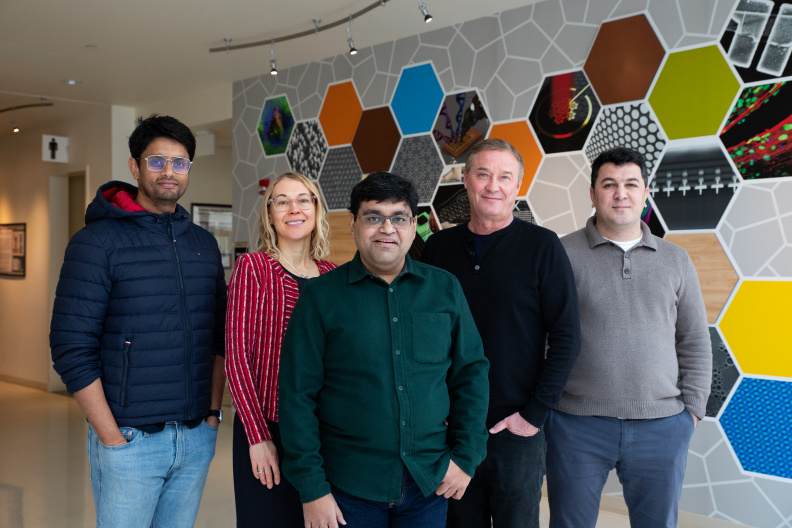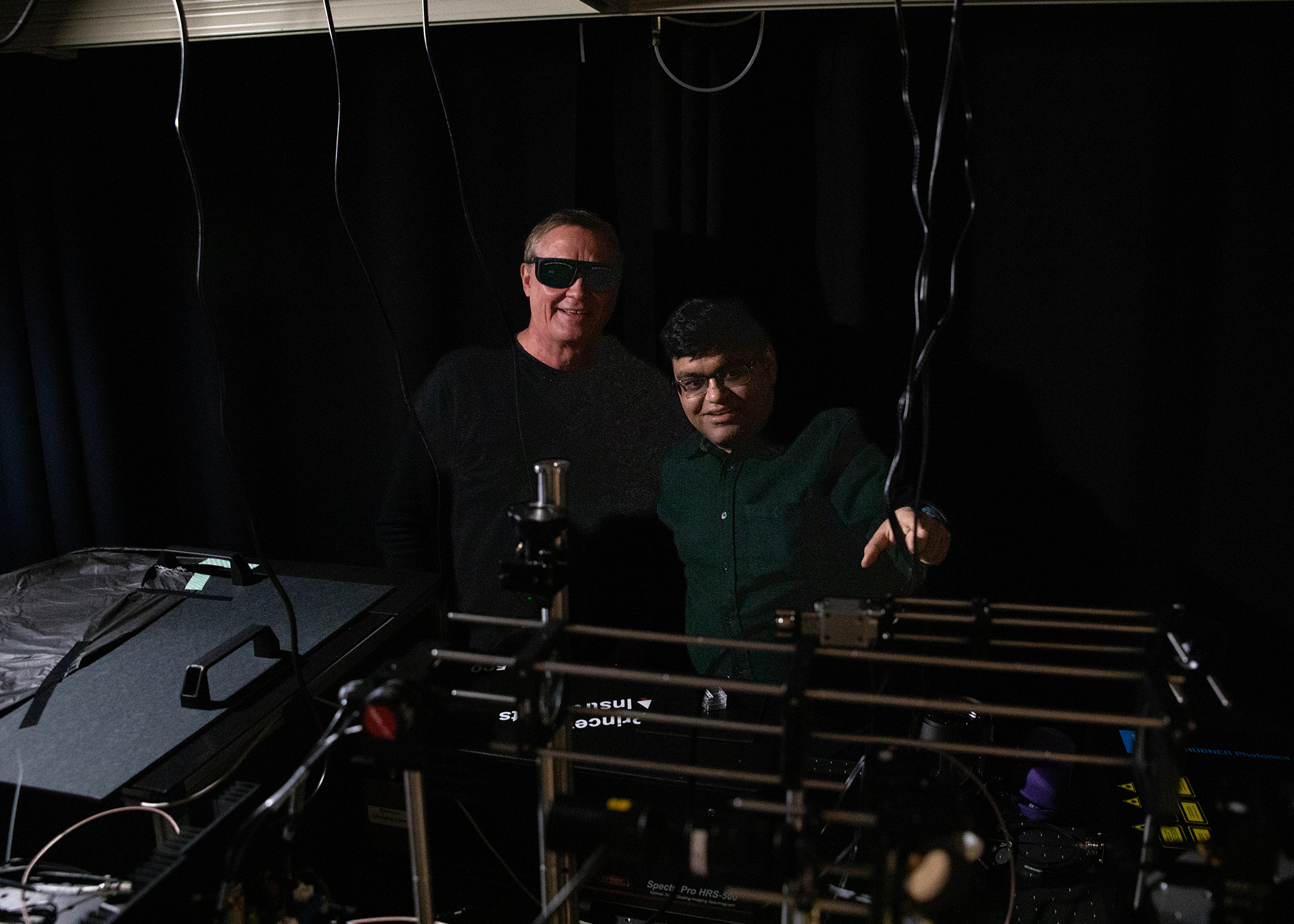Pioneering quantum spin liquids earns Purdue Scientists and Engineers a prestigious W. M. Keck Foundation Grant
2025-02-11
Purdue researchers are aiming to confirm fractional behavior of spins that enable error-resilient quantum states
 Pramey Upadhyay (Assoc. Prof. ECE), Alexandra Boltasseva (Prof. ECE), Arnab Banerjee (Assist. Prof. PHYS), Vladimir Shalaev (Prof. ECE), and Vahagn Mkthryan (Post-doc whose initial calculations) (Purdue University/Alisha Willett )
Pramey Upadhyay (Assoc. Prof. ECE), Alexandra Boltasseva (Prof. ECE), Arnab Banerjee (Assist. Prof. PHYS), Vladimir Shalaev (Prof. ECE), and Vahagn Mkthryan (Post-doc whose initial calculations) (Purdue University/Alisha Willett )
WEST LAFAYETTE, Ind. — Quantum spin liquids are unusual states of matter where the spins stay actively in motion even at extremely low temperatures. These spins show a fascinating behavior called fractionalization, where particles seem to break into smaller parts. Purdue University researchers seek spin excitation modes, which are key in finding fractionalization using optical tools.
The project is led by physicist and Principal Investigator Prof. Arnab Banerjee with the Purdue University Department of Physics and Astronomy, along with Co-Principal Investigators from the Elmore Family School of Electrical and Computer Engineering, Prof. Vladimir M. Shalaev, Prof. Pramey Upadhyaya and Prof. Alexandra Boltasseva. All are working together to showcase the coordination between the Colleges of Science and Engineering and tackle a challenge that will advance both fields. They will start work with senior research associate Vahagn Mkhitaryan (ECE), whose initial calculations were instrumental to the grant, and graduate students Abhishek Solanki (ECE), Mohan Neupane, and Hamza Ather (PHYS), as well as collaborator theorist Prof. Johannes Knolle from TU-Munich.
The team has been awarded a $1.2 million W.M. Keck Foundation grant. The W.M. Keck Foundation focuses on high-impact research programs that strive to create far-reaching benefits for humanity by supporting outstanding science, engineering & medical research and organizations that enrich the lives of children, youth, and families.
“It is a deep honor to see the faith placed in us by such a respected organization as the W.M. Keck Foundation. Hard problems require risky research. But it is delightful to see that there are institutions which expect us to get there and follow through on what could be truly giant steps in science and technology,” says Banerjee. “By helping us solve major science and engineering challenges in heat dissipation, light enhancement and magnetic fields, the Keck Foundation grant can help us cross a really big hurdle in quantum magnetism towards future applications in quantum computing, which can potentially affect all walks of our lives.”

Vladimir Shalaev (left) and Arnab Banerjee (right) in front of the optical table containing the Raman setup and a cryostat fitted to a high-field magnet that would be used for the project. (Purdue University/Alisha Willett)
The importance of the research will show Banerjee and his team that the "split" particles show non-abelian anyonic behavior, which is crucial for building error-resilient quantum computers. The field has tremendously advanced in the past 7-8 years. However, there is still uncertainty about this "splitting" behavior, and their research aims to confirm it.
“Here we use a technique called Brillouin Raman Scattering combined with state-of-the-art sample synthesis of two-dimensional magnets and metasurface strain and signal enhancement, in combination, to tackle this question,” explains Banerjee. “We want to produce very high effective magnetic fields in these materials that are 5,000,000 times Earth’s magnetic fields, which are impossible using normal laboratory magnets.”
Prof. Arnab Banerjee says this technique will be the first ever attempted. “Additionally, the project offers unique opportunities to further develop and exploit novel nanoscale quantum sensors to probe quantum matter,” says Upadhyaya. Particularly, the team will use NV (nitrogen-vacancy) Center diamonds to detect spin fluctuations and develop novel heat dissipation techniques using metasurface methods. The research is technically challenging and high-risk and requires close collaboration between physics and engineering. Besides Physics, the research will be performed in the state-of-the-art Birck Nanotechnology Center at Purdue University, equipped with world-leading 10,000 sq-ft cleanrooms and many of the required facilities for the project.
“Within this project, we plan to employ the unique properties of metasurfaces that can enhance both the coupling to light and the strain-induced artificial magnetic fields, enabling the elusive topological quantum matter that promises fault-tolerant and scalable quantum computing,” says Shalaev.
The team hopes that the results could supercharge the field where scientists and engineers can hone into these energy levels to use these to make solid-state error-resilient quantum gates, much like has been performed in the field of Fractional Quantum Hall Effect.
The $1.2 million grant is for three years and funds one postdoc and two graduate students for the entire duration of the research. It will also allow Banerjee and his team to buy the necessary equipment for materials synthesis, strain engineering, thin-film optics, and Brillouin Raman spectroscopy.
“I congratulate Professor Banerjee and his team for securing this support from the Keck Foundation,” says Prof. Gabor Csathy, Head of the Purdue University Department of Physics and Astronomy. “The Keck Foundation is known to support projects that promise high impact, are novel in their approach, and question current paradigms. Professor Banerjee and colleagues will tackle one such project in quantum spin liquids, a highly promising area expected to yield a host of new fundamental physics results which will enable applications of Quantum Sciences. Purdue’s emphasis on scientific excellence and investment in strategic initiatives allowed the University to attract young talent, including Professor Banerjee.”
About the W. M. Keck Foundation
Based in Los Angeles, the W. M. Keck Foundation was established in 1954 by the late W. M. Keck, founder of the Superior Oil Company. The Foundation’s grant making is focused primarily on pioneering efforts in the areas of medical research and science and engineering. The Foundation also supports undergraduate education and maintains a Southern California Grant Program that provides support for the Los Angeles community, with a special emphasis on children and youth. For more information, visit www.wmkeck.org
About the Department of Physics and Astronomy at Purdue University
Purdue’s Department of Physics and Astronomy has a rich and long history dating back to 1904. Our faculty and students are exploring nature at all length scales, from the subatomic to the macroscopic and everything in between. With an excellent and diverse community of faculty, postdocs and students who are pushing new scientific frontiers, we offer a dynamic learning environment, an inclusive research community and an engaging network of scholars.
Physics and Astronomy is one of the seven departments within the Purdue University College of Science. World-class research is performed in astrophysics, atomic and molecular optics, accelerator mass spectrometry, biophysics, condensed matter physics, quantum information science, and particle and nuclear physics. Our state-of-the-art facilities are in the Physics Building, but our researchers also engage in interdisciplinary work at Discovery Park District at Purdue, particularly the Birck Nanotechnology Center and the Bindley Bioscience Center. We also participate in global research including at the Large Hadron Collider at CERN, many national laboratories (such as Argonne National Laboratory, Brookhaven National Laboratory, Fermilab, Oak Ridge National Laboratory, the Stanford Linear Accelerator, etc.), the James Webb Space Telescope, and several observatories around the world.
About Purdue University
Purdue University is a public research university leading with excellence at scale. Ranked among top 10 public universities in the United States, Purdue discovers, disseminates and deploys knowledge with a quality and at a scale second to none. More than 107,000 students study at Purdue across multiple campuses, locations and modalities, including more than 58,000 at our main campus in West Lafayette and Indianapolis. Committed to affordability and accessibility, Purdue’s main campus has frozen tuition 13 years in a row. See how Purdue never stops in the persistent pursuit of the next giant leap — including its comprehensive urban expansion, the Mitch Daniels School of Business, Purdue Computes and the One Health initiative — at https://www.purdue.edu/president/strategic-initiatives.
Written by: David Siple, Communications Specialist, Purdue University Department of Physics and Astronomy
Contributors:
Arnab Banerjee, assistant professor, Purdue University Department of Physics and Astronomy
Vladimir M. Shalaev, professor, Purdue University Elmore Family School of Electrical and Computer Engineering